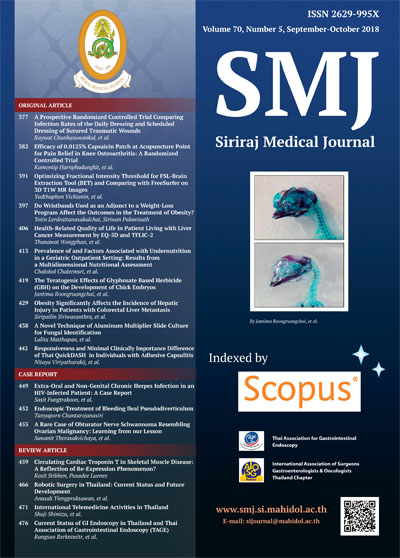A Novel Technique of Aluminum Multiplier Slide Culture for Fungal Identification
Keywords:
Slide culture technique; fungal identification; morphological identificationAbstract
Objective: Single slide culture technique (SSC) is the standard method of preparing fungal colonies for species
identification. As contamination was frequently found, restarting the process wasted time and delayed diagnosis for
patients. Aluminum slide culture (ASC) is the novel method, which aims to increase more fungal colonies in same
time. Even through, some colonies showed contamination, there would be others left to use for identification. This
study aimed to evaluate contaminate rate and time consumed in ASC technique to identify mold fungi compared
to SSC.
Methods: ASC and SSC were used to identify 50 fungal colonies comprising 3 species of dermatophytes including
Trichophyton mentagrophytes, T. rubrum, Microsporum canis, and 2 species of non-dermatophytes including
Neoscytalidium dimidiatum and Fusarium solani which are common causative molds for superficial fungal skin
and nail infection. Fungal colonies were microscopically examined every 5 days. Time to species identification and
contamination rate were recorded and analyzed.
Results: This study demonstrated that ASC had equal efficacy in fungal identification with SSC. Median time from
inoculation to fungal identification in ASC technique was 15 days which was significantly less than in SSC technique
(18 days, p-value ≤ 0.05). At 15 days after inoculation, contamination rate revealed 2% in ASC whereas in SSC it
was significantly higher at 16%.
Conclusion: ASC technique is an effective alternative method to prepare fungal colonies for identification. This
study demonstrated that ASC uses less time to identify mold fungi and revealed lower contamination rate than
SSC technique.
Downloads
Published
How to Cite
Issue
Section
License
Authors who publish with this journal agree to the following conditions:
Copyright Transfer
In submitting a manuscript, the authors acknowledge that the work will become the copyrighted property of Siriraj Medical Journal upon publication.
License
Articles are licensed under a Creative Commons Attribution-NonCommercial-NoDerivatives 4.0 International License (CC BY-NC-ND 4.0). This license allows for the sharing of the work for non-commercial purposes with proper attribution to the authors and the journal. However, it does not permit modifications or the creation of derivative works.
Sharing and Access
Authors are encouraged to share their article on their personal or institutional websites and through other non-commercial platforms. Doing so can increase readership and citations.











